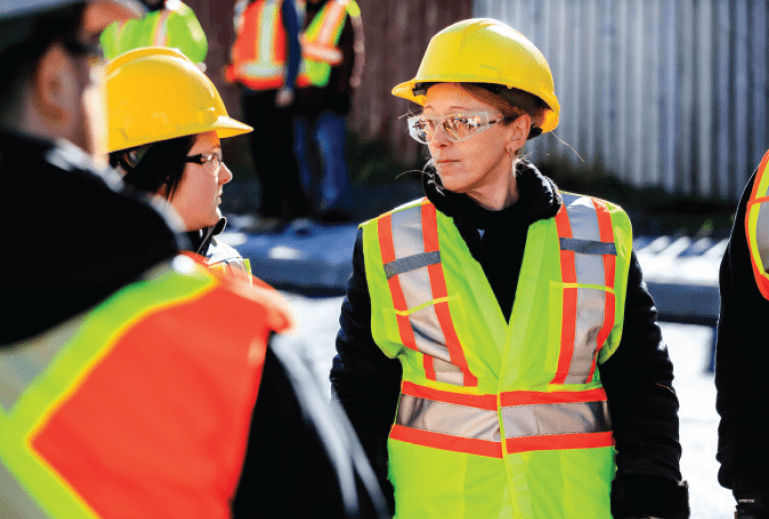
Personal Protective Equipment (PPE) has become a commonplace term in light of the COVID-19 pandemic, but for the construction industry, it’s long been a critical tool of the trade. Hardhats, safety glasses, high visibility clothing, hearing protection, fall arrest harnesses – these are just some examples of PPE that serve as a last line of defense against the hazards a worker might face on any given jobsite. However, for PPE to work correctly, it must fit the wearer correctly.
As the number of women working in the construction industry continues to increase, the fit of PPE comes into question: does the PPE fit the wearer according to manufacturer specifications and does it fir the work being done according to legislative guidelines or standards?
“In almost every situatin, PPE is not gender-specific and can be used by both men and women alike,” said Laura Matos, senior safety advisor, Construction Safety Association of Manitoba (CSAM). “The key to PPE is fit. PPE must fit the task and fit the wearer.” PPE for women has been available for more that a decade, but recently more variety and sizes are emerging. “Women bring tremendous value to the construction industry, and while gender-neutral PPE can work, it’s certainly nice to see more variety in PPE to make the industry more inclusive and to find the right fit,” Matos said.
Properly fitting PPE can help the wearer to feel more comfortable at work, but it’s also the law. For example, as per Part 6 of Manitoba’s Workplace Safety and Health (WSH) Regulation, legislation does not specify separate fir requirements for men and women, but it does specify that all PPE must correctly fit any wearer.
“So, while women’s PPE can offer more variety, if gender-neutral PPE fits you correctly and is what is available, don’t stress – it will do the job,” Matos said. “Workers should always wear and use PPE according to manufacturer specifications. in Manitoba, it is require that workers are trained in the use and care for both basic and specialized PPE before using it; to ensure the equipment is in good working order and fits the wearer correctly.”
She says that the availability of PPE for women has been somewhat slow to catch on due to two factors. “Construction has typically been a male-dominated industry, so there hasn’t been as much promotion of female-specific PPE. And as I mentioned earlier, the majority of PPE is not gender-specific.”
Items like safety glasses and hearing protection would fall into the category of gender-neutral, wherein men or women could wear these items almost interchangeably with little change in fit. However, there are a couple areas of PPE in which women may require equipment designed for their bodies – specifically footwear and fall arrest harnesses.
“I wear a women’s size 7 [shoe], which is quite hard to find in men’s shoe sizes,” Matos said. “It’s important to have a shoe that actually fits you in terms of ease and comfort, but having CSA [Canadian Standards Association]-approved footwear that is designed for your specific foot will also aid in the prevention of everything from foot fatigue and to foot, back to joint pain.”
In Manitoba, Part 6.12 of the WSH Regulations states that a construction worker is reponsible for getting their own protective footwear that is appropriate for the task and that meets CSA standards. Fall arrest harnesses are designed differently for men’s and women’s genitalia to reduce stress on the body if a fall occurs. In the event of al fall, a worker can have nearly 1,800 pounds of force exerted on their body – particularly to the groin and legs – while wearing a harness.
Again, WSH legislation doesn’t require gender-specific PPE, but Part 14.18 of the WSH Regulation says a full-body harness must be properly fitted to the worker. “It is extremely important to make sure the harness is appropriate for the user – regardless of gender – and is properly fitted to avoid serious or even fatal injury,” Matos said.
The harness should be fitted by a professional, rather than assuming what might be a good fit. Matos says an improper fir on a fall arrest harness can lead to serious injury or death in the event of a fall. “Women, like men, come in all shapes and sizes, and knowing exactly how the equipment will fit correctly is key. In many cases, men’s or gender-neutral PPE will work and fit just fine, but in some instances – safety footwear and fitted PPE – women-specific PPE can provide more options for different body types and sizes.” Matos said.
“There are more skilled, competent women entering the construction industry every day. With the culture of safety evolving and reaching new heights in Manitoba, companies will be wanting to ensure their workers are all properly protected from the hazards they will be exposed to. As a last line of defense, properly fitting PPE will be the difference betweek life and death.”